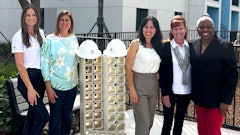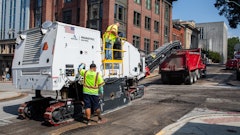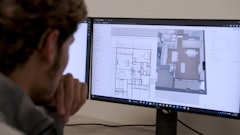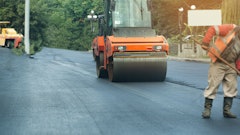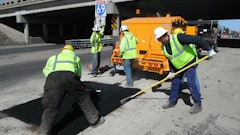
Road building doesn't exist in a vacuum. It is one system that exists alongside many others, and examining what influences and effects these interconnected groups is known as, "systems thinking."
From the Southern New Hampshire University's (SNHU) website, “Systems thinking is about investigating what set of factors and interactions are contributing to or could contribute to a possible outcome,” said Steve Brown, deputy director of collaborative learning and strategic insight at the school. “Systems thinking is useful in helping teams become more aware of how they’re interacting with each other and within the team, and it helps them understand the outcomes they’re producing,” Brown said.1
Taking this holistic approach to your business, to your organization, your crews, and even the designs of roads themselves has a broad amount of applicability. Christina Dumeng, associate dean of business programs at SNHU, said, “Thinking about the impact of any system as it relates to decision making is important in understanding the broader scope of how all of the pieces in your organization connect.”1
From Institution to Application
One example of systems thinking in asphalt production, a very complex system in and of itself, is that of aggregate sourcing. Think about the production of asphalt at the plant as one system. All the factors contained at the plant itself are apart of it. The source of aggregates is another, outside system, and changes in regulation, environmental conditions, permitting, availability, quality, reclaimed asphalt pavement (RAP) usage, etc. can all suddenly, and without warning, effect your internal asphalt production system.
The better you grasp how systems like these create a greater paradigm can mean the difference between efficiency and profitability, but, in some ways it can mean the difference between even more important things. Inversely, to ignore the way these forces interact doesn't negate the power of their influence.
While significant investments are often made on the front-end of our industry systems (materials, production, training, efficiency, etc.), there's not as much attention paid to the back-end systems, i.e. what happens after. What are the systems that our product impacts? The communities. Infrastructure influences not just the economic futures of a city or a town, they have a material effect on the lives of people who live in the aftermath.
Understanding our industry's place in the broader scope of systems at work in our communities' infrastructure means being a responsible actor within it. To become more aware of how the things we build play a role in our community's economic health, as well as the wellbeing of its people, means reckoning with its history in order to ensure a better future.
The Ties That Bind
In July of 2023, a report called "Divided By Design" detailed the damage caused to low-income and communities of color by the federal highway program.
A press release by Smart Growth North America, a national nonprofit that works on issues of land use, transportation, and economic development policy, explained that, "Through novel analysis, the report illustrates the historic inequities created by and in the federal transportation program, examines how current practices continue to exacerbate those inequities today, and shares recommendations for a new approach to transportation that leads to equitable outcomes."
These aren't baseless or purely ideological concepts. A bipartisan congress built $1 billion into the Inflation Reduction Act (IRA) for the Reconnecting Communities program, the first federal program of its kind, which tacitly and explicitly acknowledged the role of the interstate system in creating historic inequities across the country.
From the Federal Highway Administration's (FHWA) February 2023 press release describing the project:
Transportation infrastructure should help people get where they need to be, but, too often in our nation’s history, transportation infrastructure has done the opposite by dividing neighborhoods and cutting off communities from opportunity. For example, highways and rail lines can be physical barriers, preventing residents from easy access to social and economic opportunities. This burden is often felt most by communities of color.4
 Breakdown of funding per type of project.From the Reconnecting Communities Institute
Breakdown of funding per type of project.From the Reconnecting Communities Institute
The response to the program has been overwhelmingly positive. A total of 435 project proposals were submitted from 48 different States, District of Columbia, America Samoa, and Puerto Rico. The grand total amount of funding contained in these requests was in excess of $2 billion, doubling the entirety of the program's budget through 2026. Of these 435 proposals, 45 were approved in 2023 and were set to receive the first batch of funding to the tune of $185 million. The awards break down into 39 Planning Grants and six Capital Construction grants.
The Biden administration originally wanted a whopping $20 billion for this program, which might have been extreme, except the massive response seems indicate the first figure was much closer to the actual level of need.
"It's a huge step forward to recognize both the mistakes and the damage created in the past, and then setting aside money to try and fix those problems," Said Steven Davis, VP of transportation strategy and assistant VP at Smart Growth. "It's like trying to fill back in a hole with a teaspoon that was dug out with a excavator. It is not going to make a meaningful dent in a problem that's still being created, but it is absolutely a step in the right direction."
"However, it's sort of endemic of the way that Congress tries to solve problems in transportation, which creates small new programs to address the problems that are still being created by the bulk of the large programs. For example, we are in the middle of displacing 600-to-800 people in Houston, TX, to widen I-45. That's not that different from what we did in the 1960s."
All this funding, the program itself, and the speeches made about it are worthless if on the other end of the pole the very same methods that got us here in the first place are carrying on building the next generation's burden of correction. In order to process real change, the methods have to change.
To really understand what needs to change and why, requires a new taxonomy. A new set of definitions for the work that road building and infrastructure does.
Rethinking Old Classifications
Davis believes part of the problem lies in the very way that the government talks about infrastructure. "We're fond of saying that things like highways are assets, but they are not assets. They are liabilities," he said. "We treat them as assets on the balance sheet, when we really should be treating them as liabilities."
Davis continued by explaining how the systems of the past directly influence the systems of the present.
"The models, measures, and the standards that every transportation agency uses today were not created whole cloth in the 2000s or in the 2010s. They all have their roots in the same systems, models, and measures from the 1960s," he said. "We plowed through black, low-income, and any neighborhoods that had the lowest amount of political power to be able to resist. Today, you can have the best intentions possible, but if you are using the broken tools, you will be doing damage and creating broken places."
 A graph of displaced household statistics during the expansion era of the federal interstate system.From the Reconnecting Communities Institute
A graph of displaced household statistics during the expansion era of the federal interstate system.From the Reconnecting Communities Institute
Any benefit-cost analysis for competitive federal funding (grant programs, etc.) will include the value of time for drivers while neglecting the impact on the value of time for all other people, like people walking, biking, or using transit. The value of their time is never even considered. These estimates are related solely to vehicle speed of travel along a particular stretch of a corridor.
In looking at only speed in this way, the federal government allows a project sponsor to take credit for saving travelers’ time even if the project:
• Lengthens the distance of travel for drivers on the corridor and adds to travel time (e.g. disallowing left-hand turns, requiring a roundabout trip);
• Creates delay for people traveling across the corridor (e.g. creating gaps or disconnections in the adjacent street network);
• Creates delay for people crossing the corridor on foot or bike (e.g. removing crosswalks or intersections producing longer trips on foot, increasing the road width).
Considering that in most urban areas, a greater share of people walking or taking transit are more likely to be lower- income or people of color, it’s easy to see how this value of time measure prioritizes certain people over others.
Policies and guidance like these, and many others, were put in place in the post World War II era when the make-up of cities began to rapidly change. This was largely due to the influence of the GI Bill and the National Housing Act, which contributed to the widely known effect of "white flight" and, in turn, made city and state officials concerned about potentially negative impacts on their urban economic centers.
Here we have a great example of how three very large systems interacted:
- An influx of wealth and available housing (though often off-limits to non-white buyers) drove a population migration to the suburbs.2
- City and state officials used federal highway construction funds to build freeways connecting the suburbs to city centers favoring that population group, while simultaneously demolishing and cutting off marginalized communities from those same opportunities and resources.2
- The large scale replacement of population dense housing and local businesses that generate economic value, taxes, etc (assets) in urban areas, with freeways and other infrastructure (liabilities) gradually produces a world that resembles what we know today: A.) An affordable housing crisis B.) The erosion of public transit and accessible communities C.) Municipalities that can't afford the upkeep and maintenance of existing roadways, bridges, etc.6,7,8
Propositions For A Different Future
All of this information has one goal in mind: advocacy. What changes can we advocate for? Here is a summary of some of the changes that would transform the infrastructure we build:2
Measure What Matters
State DOTs should measure access to everyday needs. The daily work commute has long been the only metric taken into consideration when it comes to time savings, it's time to expand that data using modern technology to include and measure all trips. This would allow for a more accurate view of the whole transportation picture. How is the infrastructure or potential infrastructure impacting the way people live in a particular community. Before new or expanded roadways can be built, the negative impacts on the economic and housing situations must be taken into account: the losses in business, tax, housing/property values, etc. Additionally, the public transportation system for a given zone should be measured and compared between its overall performance and its performance in marginalized communities.
Learn From History Instead of Repeating It
The historic damages done and briefly written about in this article must not be perpetuated any longer. If you want to further your understanding of these issues, the source list for this article is a good starting point, but, by no means, is it exhaustive. Many, many people way more educated than myself have written at length on these topics. More monies from this point forward must be spent dedicated to connecting communities in equitable ways, that don't, in turn, cut-off others. Finally, one of the biggest changes should be a shift away from building new highways or expanding existing ones, and shift funding and attention to repairing and maintaining existing structures.
Prioritize Safety Over Speed
The federal government has invested a huge amount of money and resources into roadway safety under it's Vision Zero initiative. Unfortunately, traffic deaths continue to go in the wrong direction statistically. There are a host of reasons for that which don't pertain to the road building industry, but the aspect of safety that does involve us is in regards to engineered safety designs that promote traffic calming, improved crosswalks, and other models that prioritize safety over speed. The recently updated Manual on Uniform Traffic Control Devices for Streets and Highways (MUTCD), makes some significant leaps forward in this regard9, and will now be updated on a more frequent schedule.
Examine Land Use and Transportation Together
Information on how land use effects transportation, and the other way around, should be easier to access and integrate during the design and decision making process. The federal government could create specific methods and tools that measure these interconnected impacts. As well as updating land-use and zoning regulations that take into account people's access to essential jobs and services, whether they drive a car, use public transit, or walk. What does that mean? Well, there are some fairly archaic zoning laws that prevent or limit the construction of certain forms of housing in certain areas. A Multi-use zoning approach could improve access to transit, services, and economic activation.
As members of the National Asphalt Pavement Association (NAPA) we are part of a large influential body representing the majority of our collective industry. NAPA and your State Asphalt Pavement Associations (SAPA) are ways to get involved with advocacy in several ways. Joining a committee, signing up for various opportunities, and attending to the annual and mid-year meetings are great ways to engage with these systems in new and active ways. Members' voices make a difference, and they direct the future of the industry itself by engaging with the Department of Transportation (DOT) at every level. This is where multiple systems intersect that impact what we do and how we do it, and it is also where you can make a difference.









